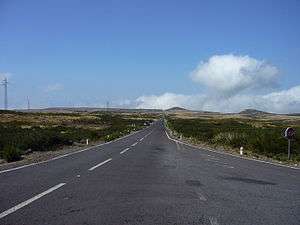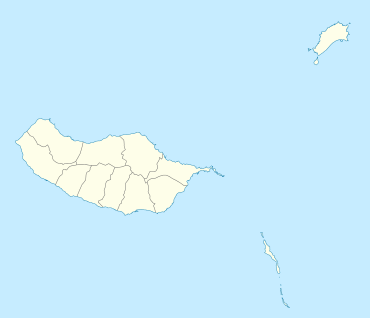Paul da Serra
Paul da Serra in the municipal county of Ponta do Sol, Madeira, it is the largest and most extensive plateau of Madeira about 24 square kilometres (9.3 sq mi), with an altitude average of about 1,500 metres (4,900 ft). Its highest point is the peak pico do Paul at 1,640 metres (5,380 ft) from where you can admire the length of the entire plateau. On days with good visibility, both the south and north coasts are visible.[1]
| Paul da Serra | |
|---|---|
 | |
| Highest point | |
| Peak | Pico do Paul |
| Elevation | 1,640 m (5,380 ft) |
| Coordinates | 32.7333°N 17.0500°W |
| Geography | |
 Paul da Serra | |
| Country | Madeira, Portugal |
Paul da Serra is considered the most important area of the islands groundwater recharge, and their planar structure facilitates the infiltration of a significant part of high rainfall year, while slowing the runoff towards the sea.
The ground cover in almost all the Paul da Serra, is composed of underbrush, reminiscent of its former use as grazing site, stressing among other the Feiteira (Pteridium aquilinum), Highland bent, (Agrostis castellana), broom (Cytisus scoparius ssp. scoparius, C. striatus and C. multiflorus), the gorse (Ulex europaeus ssp. latebracteatus and U. minor), St. John's wort (Hypericum perforatum) or pelicão (linarifolium Hypericum and H. humifusum) and Thymus micans, an endemic species of Madeira, confined to the central mountain massif.
With the abandonment of grazing due to government policies for environmental recovery, the island's mountains can be seen recovering, slowly but consistently, vegetation thought to be the original, before slaughter by the colonizers. This vegetation, mainly composed of heather species Erica arborea and Erica platycodon ssp. maderincola, heathland form of altitude sized tree up to 9 metres (30 ft) high, as observed in the area of Bica da Cana, in the northeast of the plateau. However, the cedar-of-Madeira (Juniperus cedrus ssp. Maderensis) that should have been part of that original vegetation, hardly will again take its place.
As a flat area, it is favorable to the installation of wind farms. Virtually all wind energy produced on the island comes from these.
References
- "Paúl da Serra". Retrieved 2016-10-23.